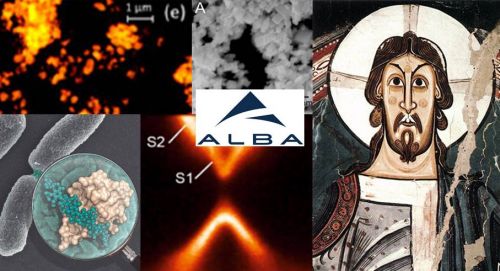
14/01/2020
The Alba Synchrotron has lots of tricks up its sleeve!
The Alba Synchrotron has lots of tricks up its sleeve!
News released last month by the Alba Synchrotron inform us about some experiments carried out in fields as different as cultural heritage, energy or life sciences, using no less than 6 of the different beam lines available at Alba. Let’s take a look at this diversity of scientific researches and experimental approaches carried out at our synchrotron!
Historically, Aerinite is a blue pigment used in many Romanesque paintings of the Pyrenean zone between the XI-XIV centuries. Researchers from the ICMAB-CSIC and Alba have identified for the first time brown aerinite. The experiment was carried out at the MSPD beamline.
Other researchers from ICMAB-CSIC and Alba, jointly with the University of Bologna and the Helmholtz Institute Ulm used the CLAESS and MISTRAL beamlines to unveil the central role of manganese in the limited cycle-life of lithium-ion batteries.
For its part, a research group from the Institute of Energy Technologies (INTE) and the Department of Chemical Engineering — both from the Universitat Politècnica de Catalunya — is working on catalysts to get more effective hydrogen production reactions. Experiments carried out at the CIRCE beamline have allowed the researchers to determine the best support for the nanoparticles used in the process.
In another domain, the high division rate of bacteria is one of their best weapons against antibiotics. A team from the Rocasolano Institute of Physical Chemistry (IQFR-CSIC) in Madrid, Spain, the University of Notre Dame in the United States and the National Centre for Biotechnology (CNB-CSIC) in Madrid, Spain, has revealed the structure of a key machinery in the process of bacterial division thanks to the X-ray crystallography technique of the XALOC beamline.
Last but not least, a large group of chemists, theoretical and experimental physicists from Germany, Russia, Spain and Azerbaijan has developed the first intrinsically magnetic topological material. This material is very promising for the development of antiferromagnetic spintronics, 2D magnetism and quantum transport without the need for strong external magnetic fields. Part of the experiments has been performed at the BOREAS beamline.
To read more about these experiments.
Historically, Aerinite is a blue pigment used in many Romanesque paintings of the Pyrenean zone between the XI-XIV centuries. Researchers from the ICMAB-CSIC and Alba have identified for the first time brown aerinite. The experiment was carried out at the MSPD beamline.
Other researchers from ICMAB-CSIC and Alba, jointly with the University of Bologna and the Helmholtz Institute Ulm used the CLAESS and MISTRAL beamlines to unveil the central role of manganese in the limited cycle-life of lithium-ion batteries.
For its part, a research group from the Institute of Energy Technologies (INTE) and the Department of Chemical Engineering — both from the Universitat Politècnica de Catalunya — is working on catalysts to get more effective hydrogen production reactions. Experiments carried out at the CIRCE beamline have allowed the researchers to determine the best support for the nanoparticles used in the process.
In another domain, the high division rate of bacteria is one of their best weapons against antibiotics. A team from the Rocasolano Institute of Physical Chemistry (IQFR-CSIC) in Madrid, Spain, the University of Notre Dame in the United States and the National Centre for Biotechnology (CNB-CSIC) in Madrid, Spain, has revealed the structure of a key machinery in the process of bacterial division thanks to the X-ray crystallography technique of the XALOC beamline.
Last but not least, a large group of chemists, theoretical and experimental physicists from Germany, Russia, Spain and Azerbaijan has developed the first intrinsically magnetic topological material. This material is very promising for the development of antiferromagnetic spintronics, 2D magnetism and quantum transport without the need for strong external magnetic fields. Part of the experiments has been performed at the BOREAS beamline.
To read more about these experiments.
More news
28/01/2021
Institutional visit to the Elena Renewable Gas Plant in Parc de l'Alba
12/01/2021
2021: the Alba synchrotron begins its mutation
30/12/2020
The Park has a new Urban Development Master Plan
29/11/2020
The director of Parc de l'Alba, Pere Solà, academic director of the new Postgraduate Course in Urban Planning and Health at the UPC School
18/11/2020
Catalan minister Ramon Tremosa visits the ALBA synchrotron and announces the creation of a public-private investment fund to improve knowledge transfer
03/11/2020
Catalonia, at the forefront of Europe in life sciences and health; the Alba synchrotron contributes to this leadership









